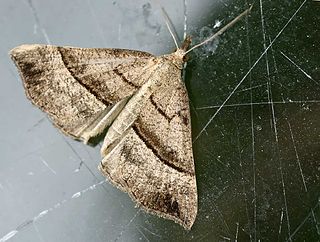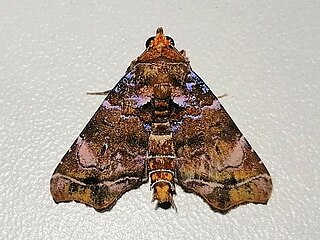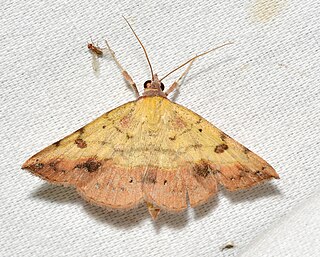
The Noctuidae, commonly known as owlet moths, cutworms or armyworms, are a family of moths. They are considered the most controversial family in the superfamily Noctuoidea because many of the clades are constantly changing, along with the other families of the Noctuoidea. It was considered the largest family in Lepidoptera for a long time, but after regrouping Lymantriinae, Catocalinae and Calpinae within the family Erebidae, the latter holds this title now. Currently, Noctuidae is the second largest family in Noctuoidea, with about 1,089 genera and 11,772 species. This classification is still contingent, as more changes continue to appear between Noctuidae and Erebidae.

The Ophiusini are a tribe of moths in the family Erebidae.

The Hypeninae are a subfamily of moths in the family Erebidae. The taxon was first described by Gottlieb August Wilhelm Herrich-Schäffer in 1851. A notable species is Mecistoptera griseifusa, which lives solely on tears it drinks with its proboscis.

The Phaegopterina are a subtribe of tiger moths in the tribe Arctiini, which is part of the family Erebidae. The subtribe was described by William Forsell Kirby in 1892. 469 species of Phaegopterina are present and 52 that are recently discovered in Brazil.

The Herminiinae are a subfamily of moths in the family Erebidae. The members of the subfamily are called litter moths because the caterpillars of most members feed on dead leaves of plants, though others feed on living leaves, and/or the mushrooms of fungi as in the case of genus Idia.

Cycnia is a genus of tiger moths in the family Erebidae. The genus was erected by Jacob Hübner in 1818.
Mursa is a genus of moths of the family Erebidae.
Aglaonice is a genus of moths of the family Erebidae. The genus was erected by Heinrich Benno Möschler in 1890.
Bandelia is a genus of moths of the family Erebidae.

Cecharismena is a genus of moths in the family Erebidae. The genus was erected by Möschler in 1890.

Colobochyla is a genus of moths of the family Erebidae.
Janseodes is a monotypic moth genus of the family Erebidae erected by Pierre Viette in 1967. Its only species, Janseodes melanospila, was first described by Achille Guenée in 1852. It is found in India, South Africa and the US state of Florida.

Isogona is a genus of moths of the family Erebidae. The genus was erected by Achille Guenée in 1852.
Euaontia is a genus of moths of the family Erebidae.

Hemeroplanis is a genus of moths of the family Erebidae. The genus was erected by Jacob Hübner in 1818.
Homocerynea is a monotypic moth genus of the family Erebidae. Its only species, Homocerynea cleoriformis, was found in the US state of Arizona. Both the genus and species were erected by William Barnes and James Halliday McDunnough in 1913.

The Anobinae are a subfamily of moths in the family Erebidae described by Jeremy Daniel Holloway in 2005. Common morphological characteristics of Anobine moths include a dark head and prothoracic collar, lighter color on the thorax, and either bipectinate antennae or antennae with flagellomeral setae in males.

The Boletobiinae are a subfamily of moths in the family Erebidae, containing about 956 species. The taxon was described by Achille Guenée in 1858.

Eulepidotinae is a subfamily of moths in the family Erebidae. Adult males in the subfamily have midtibial tufts of hairs. Adult females have the ostial opening located between the seventh and eighth abdominal sternites instead of located anteriorly on the seventh sternite.
The Omopterini are a tribe of moths in the family Erebidae.












